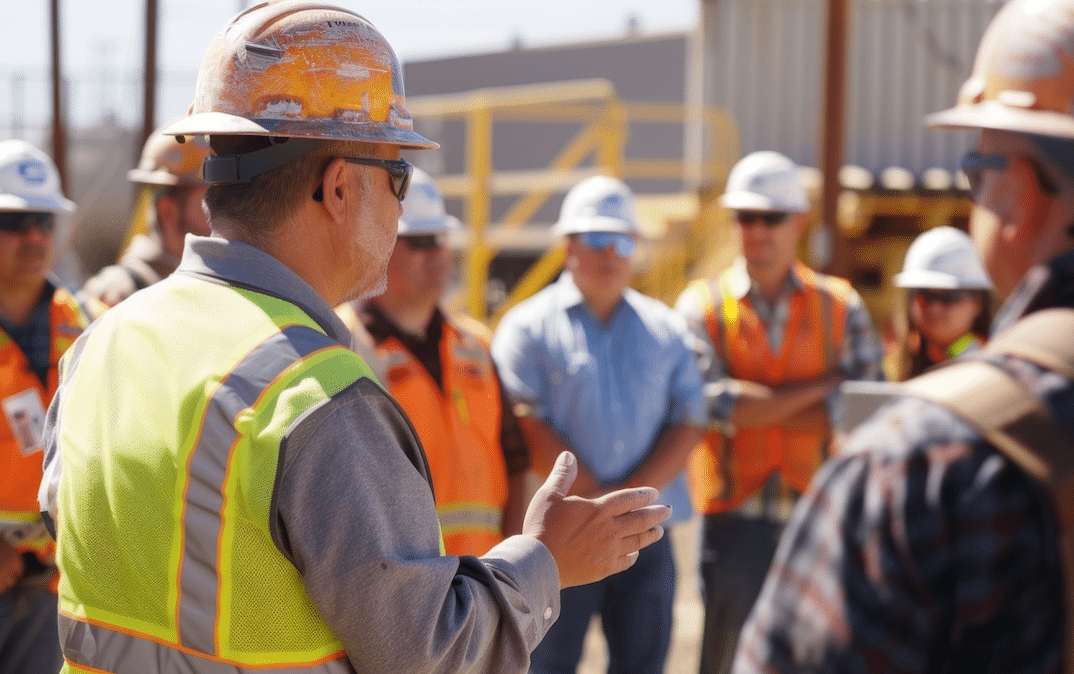Working in the scorching heat can be difficult for construction crews during the late spring, summer, and early fall months. Having a plan to take care of your team is an essential part of being an ethical construction manager.
In fact, the city of Phoenix recently passed a construction heat safety ordinance. This new law requires employers who perform outdoor work – such as construction projects – to have a written plan for heat safety.
You don’t have to manage projects in Arizona to have a heat safety plan, though. It should be a standard part of your operation to protect workers. After all, spending too much time in high temperatures can lead to heat stress, heat stroke, and other serious health issues.
Let’s review why you should have a construction heat safety plan in place so that everyone on-site can safely perform their duties during sweltering days on the job site.
Why Construction Heat Safety Matters
For construction managers, keeping workers safe in the heat isn’t just the right thing to do – it’s a smart way to avoid injuries, reduce OSHA incidents, and work toward preventing heat-related illnesses.
Statistically, OSHA reports that thousands of outdoor workers become sick and risk fatalities every year. One of the main risk factors is that the body needs time to build tolerance to extreme heat. A lack of time for “heat acclimatization” represents a significant risk.
Beyond compliance with safety regulations, heat safety sets the tone for a culture of care and resilience. It demonstrates a commitment to the well-being of employees, fostering trust and morale across teams.
From a cost perspective, reducing heat-related incidents minimizes disruptions to project timelines, such as delays caused by illnesses, accidents, or workforce shortages.
Overall, investing in heat illness prevention is not just a legal or ethical responsibility – it’s a smart, proactive strategy for building a strong, dedicated workforce and ensuring the success of construction projects.
Our Construction Heat Safety Tips for Your Crew
To help you safeguard your crew during the summer months, we’ve compiled five essential heat safety tips tailored to construction sites. Let’s review how to create a safer, more productive work environment.
1. Plan for Heat Illness Prevention
Preparation starts long before your team steps onto the worksite. A comprehensive heat illness prevention plan involves identifying risk factors such as extreme heat indexes, heavy physical activity, and personal risks like medical conditions.
You will want to ensure workers are informed about these risks and provide training on recognizing the symptoms of heat-related illnesses such as heat exhaustion, heat stroke, and muscle cramps.
Equip your team with tools such as temperature-monitoring devices and other wearable devices to assess the heat index on-site. High heat index values signal when extra measures, like additional rest breaks or limits on physical activity, are necessary to prevent heat stress.
Key Tips for Planning
- Conduct risk assessments for hot environments.
- Develop clear emergency protocols (e.g., when to call 911).
- Train supervisors and workers on heat safety.
2. Ensure Workers Stay Hydrated
One of the simplest yet most effective measures to combat heat-related illnesses is frequent water breaks. Encourage workers to drink water or electrolyte-replenishing beverages before, during, and after their shift – even if they don’t feel thirsty. Water stations should be conveniently located throughout the worksite to motivate hydration.
You will also want to ensure your crew understands the importance of staying hydrated to regulate their body temperature and maintain optimal heart rate during physically demanding tasks.
Hydration Essentials
- Provide cool drinking water within easy reach.
- Remind workers to drink water every 15–20 minutes.
- Offer electrolyte drinks to replenish lost minerals.
- Reduce the availability of sugary drinks, as they can increase fluid loss.
3. Encourage Regular Rest Breaks in Shaded or Air-Conditioned Areas
Construction sites are no place to skip rest breaks, especially during scorching weather. Heat illness can set in quickly without periods of recovery. Set up shade structures near worksites or designate air-conditioned trailers as designated rest areas for workers to cool down.
Adjust break schedules based on the heat index and intensity of physical activity. For example, consider scheduling longer and more frequent breaks when temperatures climb above a dangerous level.
Rest Break Suggestions
- Mandate regular scheduled breaks during peak heat hours.
- Rotate shifts to allow workers time to rest between strenuous tasks.
- Use shaded canopies or air-conditioned facilities as cooling zones.
4. Monitor Workers for Early Warning Signs
Supervisors must actively monitor workers for signs of heat-related illness. Symptoms of heat exhaustion include fatigue, dizziness, rapid heart rate, nausea, and profuse sweating.
If left unchecked, heat exhaustion can escalate into heat stroke, which is characterized by hot, dry skin, loss of consciousness, and confusion. If you notice a worker displaying these signs, take immediate action.
We recommend providing site supervisors with guidelines to identify symptoms and implement buddy systems. Train all staff to report symptoms in themselves or co-workers, fostering a proactive approach to heat safety.
Monitoring Best Practices
- Look for signs of heat rash, muscle cramps, or dizziness in workers.
- Rotate monitoring responsibilities among supervisors.
- Address minor issues before they escalate to severe heat illnesses.
5. Provide the Right Clothing and Equipment
Encourage your team to wear lightweight, breathable, and light-colored clothing to reduce heat absorption. Specialized personal protective equipment (PPE) designed for hot environments – like cooling vests – can further help workers keep their body temperature down.
Additionally, ensure proper footwear to reduce slips, trips, and falls, as sweating can compromise grip. Sunscreen, wide-brim hats, and sunglasses should also be recommended to minimize sun exposure risks.
Proper Gear Checklist
- Lightweight, breathable fabrics for clothing.
- PPE should include heat-resistant materials, such as cooling vests or neck wraps.
- Sunscreen and eye protection for outdoor work.
Take Action Today to Prevent Heat-Related Incidents
When construction managers prioritize heat safety, they can better protect their workforce from injuries and illnesses. By implementing effective heat safety measures, managers can significantly reduce the likelihood of incidents and drive toward better project outcomes.
Remember that your crew’s health – and your project’s success – depends on taking proactive steps to mitigate the risks of heat stress and heat-related illnesses. By implementing the five tips we highlighted today, you can do your part to create a safer work environment.
Remember: Have a plan, regularly monitor your team, and don’t cut corners on heat prevention. Taking precautions can make all the difference in construction heat safety.
– Want more tips on reducing worksite risks on the job site? Stay informed with our latest industry tips by following us on LinkedIn. We regularly share helpful articles and resources to support construction managers. Together, we can accelerate construction excellence.




